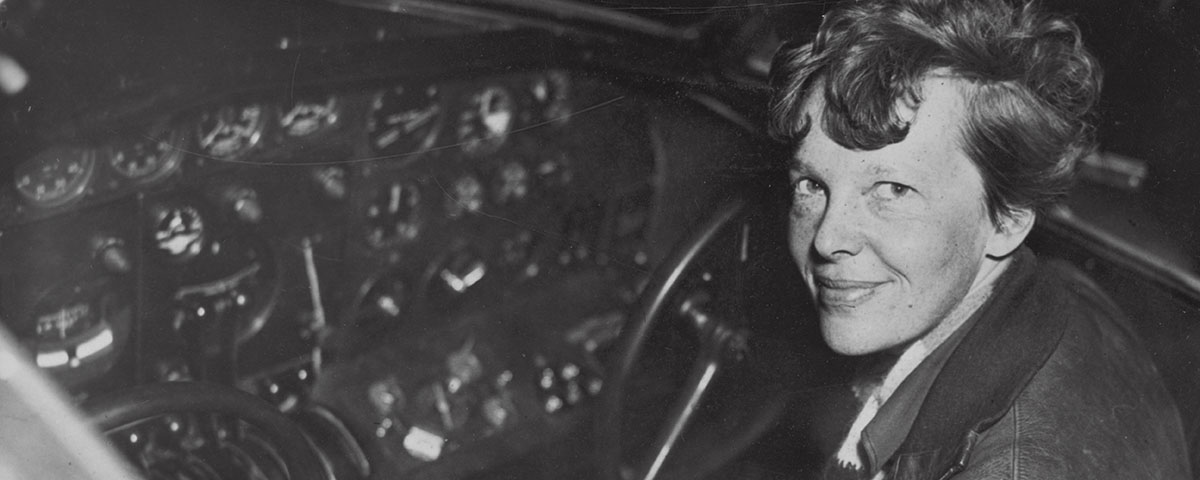They called Amelia Earhart “Lady Lindy” after her first flight across the Atlantic. She was tall and slim, with short, wind-swept hair, and looked so remarkably like Charles Lindbergh that she could have been his sister. Although she disappeared flying the Pacific in 1937, her name is still frequently in the news, thanks mostly to “aviation archaeologists” who believe they know the circumstances of her demise and where her plane and other evidence can be found.
Amelia Mary Earhart was born in Atchison, Kansas, on July 24, 1897. She referred to herself simply as “AE,” and that’s what her friends called her. Earhart was considered a tomboy because she dared to do things that girls at the turn of the century usually did not do—she climbed trees, “belly-slammed” her sled in the snow to start it downhill, and hunted rats with a .22 rifle. Later she attended a girls school in Pennsylvania and became a nurse’s aide in a Toronto hospital, helping to care for wounded soldiers during World War I.
At the time Earhart was growing up, women were beginning to assert their right to enter careers traditionally reserved for men. She kept a scrapbook of newspaper clippings that highlighted women entering occupations in motion-picture directing, law, advertising, management and automobile mechanics.
Her introduction to aviation came on Christmas Day 1920, when her father, a lawyer, took her to the official opening of a new airfield in Long Beach, California. She had her first airplane ride three days later with barnstormer Frank M. Hawks. “As soon as we left the ground,” she later said, “I knew I myself had to fly.”
Earhart took her first flying lesson on January 3, 1921, from Neta Snook, one of the first women to graduate from the Glenn Curtiss school. The flight cost $1 per minute, which Earhart paid for in World War I Liberty bonds. The airplane was a dual-control Canuck, the Canadian version of the famous World War I Curtiss JN-4 “Jenny.”
In July 1921, Earhart bought a rebuilt Kinner Airster for $2,000. The Kinner was an unstable, two-seat biplane powered by a 3-cylinder, 60-hp Lawrence L-2 engine. The airplane was painted yellow, and Earhart promptly named it The Canary.
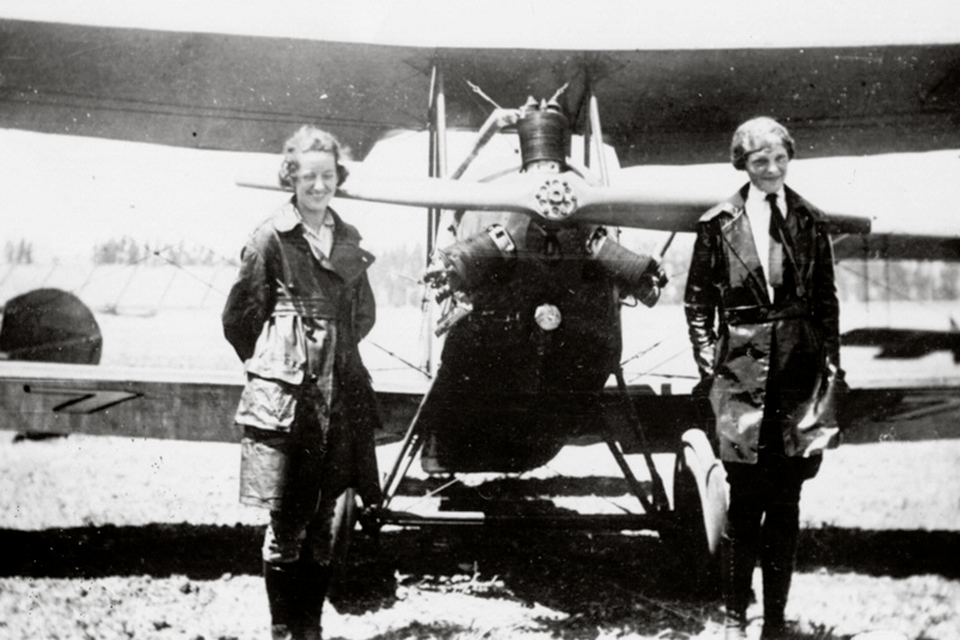
There is no denying that Earhart had difficulty learning to fly. It took her more than 15 hours of flight time and nearly a year to solo the Kinner, and she had a number of mishaps afterward, most of them during landings. As one biographer noted: “Unfortunately, though highly intelligent, a quick learner, and possessed of great enthusiasm, Amelia did not, it seems, possess natural ability as a pilot. This is no disparagement of Amelia, it is simply the view of many of her contemporaries in the flying world. Indeed, given this apparently important drawback, it is to her great credit that she was subsequently able to achieve so much.”
One aspect of Earhart’s personality proved dominant—perseverance. She was obsessed with flying and built up solo flying time in The Canary when she could afford it. She set a women’s altitude record in October 1922 by coaxing the Airster to 14,000 feet. The record was broken by Ruth Nichols a few weeks later, but the effort had put Earhart in the news.
In 1925, Earhart moved with her mother and sister to Massachusetts. She attended college, became a social worker in Boston, and taught English to immigrants. But the lure of flying remained strong. When she was financially able, Earhart invested a small sum in a local airport. She was soon back in the cockpit, where she attracted much press attention by promoting flying, especially for women.
Earhart’s life changed abruptly in April 1928, when she was invited to be the first woman to fly across the Atlantic. It was primarily a publicity effort instigated by George P. Putnam, a book publisher with a flair for finding and promoting profitable book projects. One of Putnam’s coups was Charles Lindbergh’s book We, which became a best seller after it was published in July 1927.
Some say Putnam planned to publish a book, titled “She,” about the first woman to make a trans-Atlantic flight. He was looking for “the right sort of girl”—a well-educated and physically attractive pilot. After he ruled out other women pilots, including Ruth Elder and Ruth Nichols, he chose Earhart and promptly labeled her “Lady Lindy.” Putnam would make Earhart a national heroine.
For the flight, a Fokker F7 was purchased secretly from Commander Richard E. Byrd by Mrs. Frederick E. Guest. Originally from Great Britain, Guest named the plane Friendship to represent the close ties between England and the United States. Although Earhart was said to be in command of the flight, she was actually only a passenger. Wilmer “Bill” Stutz would be the pilot, and Louis E. “Slim” Gordon would serve as the co-pilot and flight mechanic. While the details of the flight were being worked out, Earhart and Putnam became friends, but she remained leery of his promotional schemes.
Test flights were made by Bernt Balchen and Floyd Bennett, who were employed by Fokker. Friendship’s wheels were then exchanged for pontoons, and the plane was flown to Newfoundland. After a series of delays, Earhart, Stutz and Gordon left Trepassey Harbour just before noon on June 17, 1928. They flew through harsh weather, including snow squalls, but 20 hours 40 minutes later—with only 25 gallons of fuel left—Friendship was guided to a landing by an Imperial Airways Sea Eagle at Burry Port, Wales. On their return, the three were greeted with a ticker-tape parade in New York and receptions in Boston, Chicago and Medford, Mass. Earhart was also given a reception at the White House by President Calvin Coolidge.
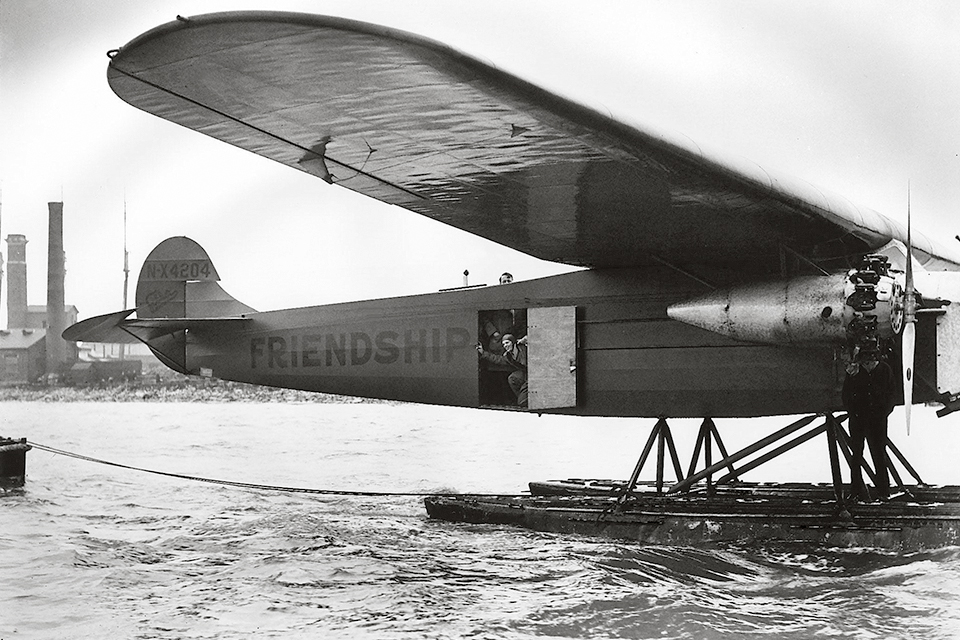
Earhart wrote a book about the flight, which she named 20 Hrs. 40 Min., went on an exhausting lecture tour in the winter of 1928-29, and became an associate editor of Cosmopolitan magazine. Her articles on aviation subjects were well-received, and she became a spokesperson for women in aviation. In July 1929, she became assistant to the general traffic manager of Transcontinental Air Transport (later to become TWA).
Earhart made her first attempt at competitive flying during the first Santa Monicato Cleveland Women’s Air Derby. The event, later named the “Powder Puff Derby” by comedian Will Rogers, took place in August 1929 as the opening feature of the National Air Races. Earhart flew a Lockheed Vega and placed third, behind Louise Thaden and Gladys O’Donnell.
Shortly after the race, 26 licensed women pilots met informally at Curtiss Field on Long Island and formed a group that was incorporated the following year as the Ninety Nines. In their constitution, they proposed “to assist women in aeronautical research, air racing events, acquisition of aerial experience, administration of aid through aerial means in times of emergency arising from fire, famine, flood, or war.” Earhart was elected the first president. Their stated aim was “to provide closer relationship among pilots and to unite them in any movement that may be for their benefit and for that of aviation in general….”
Earhart continued her writing, but she also flew to many locations where she spoke publicly about women’s flying. She became an official in the National Aeronautic Association and encouraged the Federation Aeronautique Internationale (FAI) to establish separate world altitude, speed and endurance records for women.
As soon as those records were established, Earhart got her name into the record books. She established women’s world speed records for 100 kilometers with no load, then with a payload of 500 kilograms, on June 25, 1930. Ten days later, she set a women’s world speed record of 181.18 mph over a 3-kilometer course.
Setting records was one way to keep aviation in the news, but Earhart also wanted to promote aircraft as a safe means of transportation. She helped organize a new airline in September 1930–the New York, Philadelphia and Washington Airways–and served as vice president for public relations.
Earhart’s relationship with George Putnam was becoming more serious. Ten years her senior, Putnam basked in the publicity he had brought the young flier. When he divorced his wife of 18 years, Earhart reluctantly agreed to marry him after agonizing over the decision. The wedding was held February 7, 1931. She later described their marriage as “a reasonable partnership…conducted under a satisfactory system of dual control.”
By the time Earhart was married, there were about 300 licensed women pilots in the United States, and many of them were competing for the fame that records brought. Among them were Bobbi Trout, Laura Ingalls, Elinor Smith and Ruth Nichols. Competitive by nature, Amelia needed something to keep her name in the news. Her husband ordered an autogiro for her a week after their marriage, but she did not wait for her own machine to be delivered to make another record-setting attempt. She set an altitude record for men and women of 18,415 feet on April 8, 1931, in an autogiro borrowed from the Pitcairn-Cierva Autogiro Co.
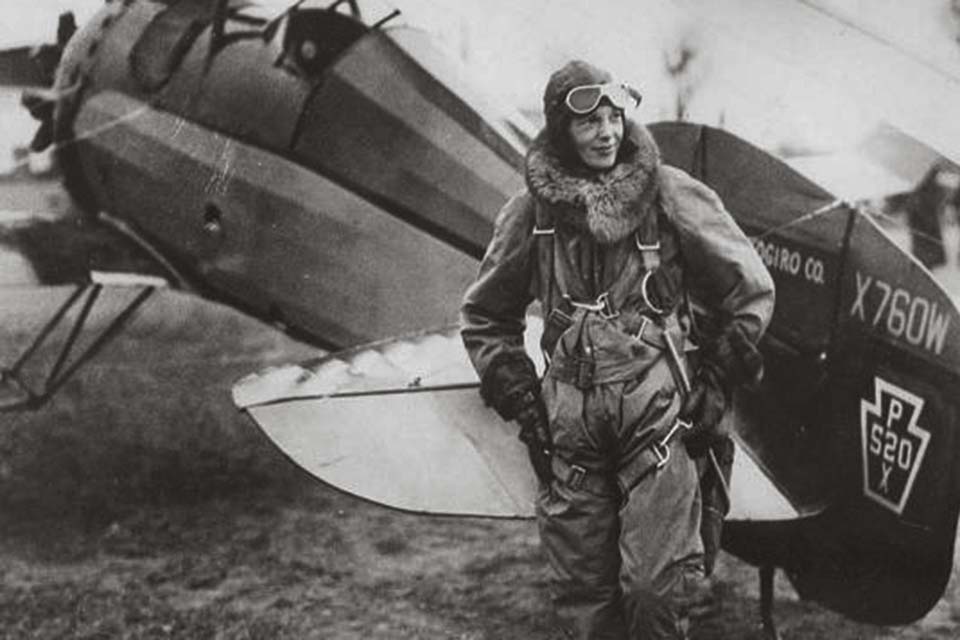
Earhart canceled her order for an autogiro when the Beech-Nut Co. offered its autogiro for a transcontinental flight; she flew it to the West Coast in nine days. She had an accident at Abilene on the return trip when, as she put it, “the air just went out from under me.” The autogiro hit two cars and damaged the craft’s rotor and propeller, but Earhart was unhurt. It was replaced by another autogiro, and she continued her trip east. However, she was issued a formal reprimand for “carelessness and poor judgment” after the accident from the Aeronautics Branch of the Department of Commerce. She made two more trips that year and had a minor crack-up in Detroit.
One January morning in 1932, Earhart put down the newspaper she had been reading and asked her husband, “Would you mind if I flew the Atlantic—alone?” He agreed, and the two of them secretly began to make preparations for her to use a Lockheed Vega she had bought in 1929. Bernt Balchen, who had piloted Commander Byrd across the Atlantic in 1927, agreed to rebuild and test the Vega, which she had damaged at Norfolk in 1930.
Balchen and Eddie Gorski, a skilled mechanic, installed a 420-gallon gas tank in the fuselage, a new engine and new instruments, including a drift indicator, two compasses and a directional gyro. Balchen taught Earhart to fly using instruments and then quietly checked her out in the renovated Vega. The weather was improving over the Atlantic, and Balchen flew Earhart to Harbour Grace, Newfoundland. She took off for Paris on the afternoon of May 20, 1932—the fifth anniversary of Lindbergh’s Atlantic flight. Fourteen hours 54 minutes later, after being driven off course by strong north winds and overcompensating for southward drift, she landed in a pasture near Londonderry in Northern Ireland. It had been a fatiguing flight through storms and icing conditions with a leaky gas line and a burned-out exhaust pipe. Lindbergh had been honored with far more awards and receptions after his trans-Atlantic crossing than he had anticipated. Now the same thing was happening to Earhart. She was besieged by reporters and photographers as she traveled to London, France, Belgium and Italy to be decorated. Back home, at a National Geographic Society dinner in her honor, she received the society’s gold medal from President Herbert Hoover. Congress voted Earhart the Distinguished Flying Cross; she was the first woman to be so honored. It was presented to her by Vice President Charles Curtis for “displaying heroic courage and skill as a navigator at the risk of her life.” In writing about the flight, Earhart said she had made it to prove that “women can do most things that a man can do.” Not everything, she added, but certainly “jobs requiring intelligence, coordination, speed, coolness, and will power.”
Next, Earhart planned another record-setting flight in the Vega. On August 24 and 25, 1932, she set a women’s nonstop transcontinental speed record, flying 2,447.8 miles from Los Angeles to Newark in 19 hours 5 minutes. The following year on July 7 and 8, she broke her own record by making the flight in 17 hours 7 minutes 30 seconds, winning the Harmon Trophy.
Earhart began preparations in 1934 to compete for a $10,000 prize offered by Hawaiian pineapple and sugar growers, hotel owners and businessmen to publicize the islands by flying from the Territory of Hawaii to the States. She acquired an updated Lockheed Vega with the latest instrumentation, two-way radio and controllable-pitch propeller. Earhart and the plane were taken by ship to Hawaii, where she ran into a storm of media criticism for planning to make the flight purely as a publicity stunt. One newspaper report was subheaded “Nothing To Be Gained, Much May be Lost, Say Aviation Experts.”
Ignoring the criticism, Earhart made a lecture tour of the islands and then left Honolulu on January 11, 1935, for Oakland, California. She followed a course drawn up by Captain Clarence Williams, a Navy navigator, and arrived without difficulty 17 hours 7 minutes later. She was the first person to fly the 2,408-mile distance alone. It was also the first flight in which a civilian aircraft carried a two-way radio.
As before, Earhart was feted and received congratulations from many prominent admirers. President Franklin D. Roosevelt wrote her a long letter, remarking, “You have scored again…[and] shown even the ‘doubting Thomases’ that aviation is a science which cannot be limited to men only.”
It had been rumored before the Hawaii-California flight that Earhart was planning to fly around the world, but other newsworthy flights were to come first. She became the first person to fly solo from Los Angeles to Mexico City on April 19 and 20, 1935, completing the trip in 13 hours 23 minutes. On May 8, she followed that with a solo flight from Mexico City to Newark in 14 hours 19 minutes.
Earhart’s fame and her continuing struggle to give women the opportunity to fly resulted in her appointment as a consultant in careers for women at Purdue University. The university trustees established a $50,000 fund for aeronautical research to encourage the study of aeronautics.
Two members of the Purdue Research Foundation donated a total of $40,000 for Earhart to buy a twin-engine Lockheed 10E Electra to be used as a “flying laboratory,” equipped with Bendix instruments, a Sperry autopilot and a radio compass. Earhart wanted to use the specially equipped craft to study navigation problems in addition to what she termed “the human reactions of flying.”
One of the interesting friendships Earhart developed at that time was with Eleanor Roosevelt. She was planning to teach Eleanor to fly, and the First Lady actually got a student permit. Mrs. Roosevelt never pursued the matter, but the two corresponded frequently.
Earhart continued to work on plans for a world eastwest flight. She planned to fly from San Francisco via Hawaii, Australia and India, across Africa to Brazil and on to New York. The longest and most difficult leg would be the long haul over the Pacific. At first, an in-flight refueling by a Navy PBY-1 over Midway Island was considered. Midway was used by Pan American Airways as a flying boat base, and there was no airstrip on the island. That idea was abandoned when Earhart learned that the Department of Commerce was establishing a weather observation station on tiny Howland Island, described as “nothing more than a sandbar,” that would include a small landing strip. Planning then centered on using Howland for refueling. George Putnam became heavily involved in bringing the project together. He made most of the planning decisions and contacts with Navy, Treasury and Commerce officials.
The flight began from Oakland on March 17, 1937, with Frederick Noonan and Captain Harry Manning, an experienced ship captain, serving as navigators, and Paul Mantz, a movie stunt pilot, acting as co-pilot. Mantz was to go along as far as Honolulu, Noonan would continue on to Howland, and Manning would stay with the flight until they reached Darwin, Australia. Earhart would fly the rest of the trip alone. Noonan, a competent navigator with a reputation for excessive drinking, had been on the Pan American pioneering runs across the Pacific. Manning was captain of USS President Roosevelt and had agreed to take a six-month leave of absence from his ship to participate in Earhart’s flight.
The 15-hour 47-minute flight to Hawaii was uneventful, and a new eastwest record between the two points was established. After a delay for weather, Earhart lined up the heavily loaded Lockheed on the runway of Luke Field (later known as Ford Island) to take off for the 1,900-mile leg to Howland. There was a crosswind as she pushed the throttles forward and gained speed. Slowly, the right wing dipped, and Earhart compensated by pulling back on the left throttle. The plane then veered to the left in a classic ground loop. Sparks flew under the airplane as it dropped to its belly.
Luckily, there was no fire and no one was hurt. But the plane had to be repaired before it could fly again, and it was shipped back to Lockheed in California. Earhart believed a tire had blown during the takeoff attempt, but that was never proved. Mantz later said that Earhart had a tendency to hold a twin-engine plane straight on takeoff solely with throttles, rather than using the rudder. In Mantz’s experience, this technique would almost always produce a ground loop.
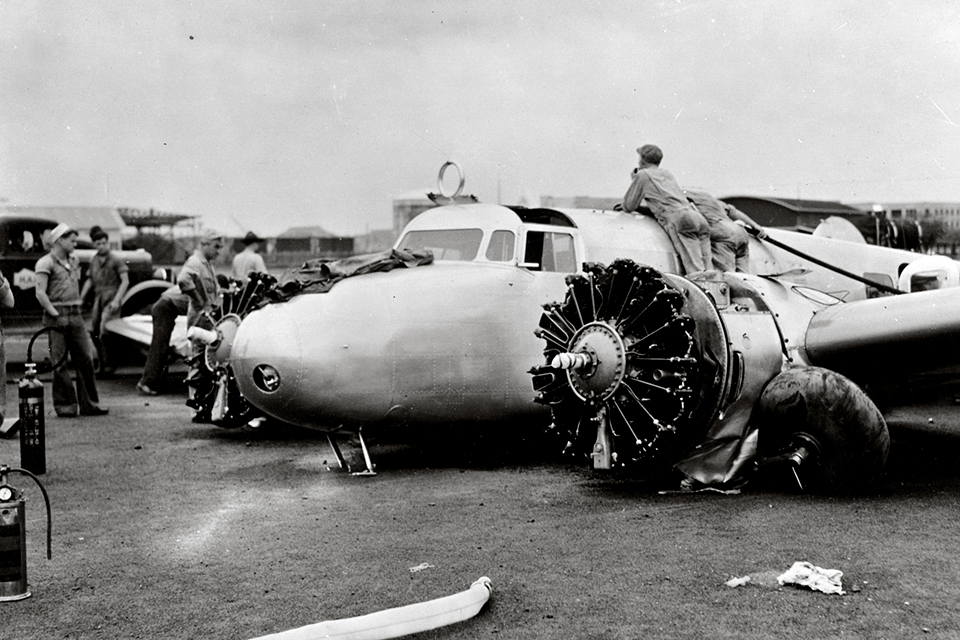
Earhart was upset by the accident but determined to make another try. She received generous checks from well-wishers, including the Lockheed mechanics who repaired the Electra. Meanwhile, she changed her plans and decided to fly a reverse route, from west to east. Captain Manning’s leave was up, but Noonan agreed to be her navigator for the entire trip.
The newly rebuilt plane was ready to go in May, and a test flight was made from California to Miami with several stops. Earhart and Noonan departed for San Juan, Puerto Rico, on June 1, 1937, and proceeded from there to Venezuela, to Brazil, and across the Atlantic to Africa. En route she ignored Noonan’s calculations in favor of her instincts. They landed at Senegal, 163 miles north of Dakar, their intended destination. They flew to Dakar, had the engines checked and then made the long, hot journey across Africa with stops at Gao, Fort-Lamy, El Fasher, Khartoum and Massawa. Noonan found navigation difficult because the few maps available were often inaccurate.
They continued to Eritrea and then nonstop to Karachi, an aviation “first”—no one had previously flown from the Red Sea to India. They reached Calcutta on June 17, having made 15 stops thus far. The aircraft had performed well, and there had been no major problems.
The next legs were to Rangoon, Bangkok, Singapore, Bandoeng and Soerbaja, Java. At that point, Earhart was having problems with the fuel analyzer and electrical instruments, and she decided to return to Bandoeng for repairs. She had a bout with dysentery, the cause of which she thought “must be the petrol fumes.” After weather delays and sightseeing, they flew on to Port Darwin, Australia, via Koepang, Indonesia. They reached Lae, New Guinea, on June 29, 1937, after a 1,200-mile flight in 73Ž4 hours.
The engines were thoroughly checked, the spark plugs cleaned, and a fuel pump and the autopilot repaired. Everything not needed for the transpacific flight, including parachutes and some survival equipment, was packed to be sent home. Earhart cabled the last of several articles to the New York Herald Tribune. She then met with senior government officials and took care of details such as fumigation of the plane, a check of immunization certificates, and customs clearance.
Noonan had trouble getting his chronometers accurately set because time signals, necessary for accurate navigation, could not be picked up by radio. There are reports that Noonan and Earhart were exhausted at that point and that Noonan got drunk, causing a delay in their takeoff for Howland, 2,227 nautical miles from Lae. Meanwhile, the U.S. Coast Guard cutter Itasca was waiting off Howland to act as a radio contact. The Navy had a weather officer and two mechanics waiting on the island with a run-in cylinder assembly, new spark plugs, oil, gas and food. A seaplane tender, USS Swan, was approximately 200 miles northeast of the island to monitor the HowlandHawaii leg. Other ships—USS Ontario and USS Myrtlebank—were positioned along the intended flight track between the Nukumanu Islands and Howland.
Earhart and Noonan had on board about 1,100 gallons of 87 octane fuel, plus 50 gallons of 100 octane for extra takeoff power. That would allow them to stay airborne between 20 and 21 hours, enough for a cruising range of approximately 2,460 nautical miles. Noonan estimated they would reach Howland in about 18-and-a-half hours.
The weather was reported favorable on July 2, 1937, although the flight would run into rain showers and overcast skies. That meant that Noonan probably would not be able to make star shots for celestial navigation. They took off from the 3,000-foot dirt strip at 12:30 p.m., in the heat of the day. The plane used every inch of the strip and disappeared briefly below a 20-foot drop off a cliff at the end. A commercial pilot reported that he saw the plane’s props throwing spray before it climbed slowly northeastward to about 100 feet and flew out of sight.
There has been much speculation about what happened in the hours that followed. Itasca made radio contact with the plane, but static interfered with transmissions. Earhart sent one clear message: “Overcast…will listen on hour and half hour on 3105 [kilocycles].” Chief radioman Leo G. Bellarts asked for her position and estimated time of arrival at Howland, then gave her weather details. When Earhart failed to report at the next scheduled time, Bellarts transmitted weather information by voice and Morse code. Earhart’s voice was heard briefly on the radio several times as dawn neared. She asked for a bearing to the ship.
At this point controversy enters the scenario. Bellarts received one message and reported it in his log as follows: “KHAQQ cling [calling] Itasca we must be on you but cannot see U but gas is running low been unable reach you by radio we are flying at altitude 1000 feet.” Another radio operator on the ship logged the report in the third person, as follows: “Earhart on NW [now] sez running out of gas only 1/2 hour left cant hr us at all/we hear her and are sending on 3105 es 500 same time constantly and listening in for her frequently.”
There was a radio direction finder on Howland, but the operator was never able to get a fix on the plane because the Electra’s transmissions were too brief. The plane had been in the air for 19 hours by that time. Suddenly, a clear voice message from Earhart was heard: “We are circling but cannot hear you. Go ahead on 7,500 now or on schedule time on half hour.”
Bellarts sent out the letter “A” continually on 7,500 kilocycles and told her to “Go ahead on 3105.” She did so immediately—the first time during the flight there had been two-way contact. Everyone on the Itasca relaxed as her message came in clearly: “KHAQQ calling Itasca. We received your signals but unable to get a minimum. Please take bearing on us and answer on 3105 with voice.”
For an hour, some signals were received from the plane at the same strength, indicating that the plane was probably circling the ship’s position. Meanwhile, Itasca had started making black smoke, which trailed the ship by about 10 miles. The log of messages received by the ship showed that Amelia did not respond to questions put to her and gave no position reports during that time. However, she did report “200 miles out,” then “100 miles out, coming up (fast).” At 1912 Greenwich time, she reported “one-half hour fuel and no landfall.” Sixteen minutes later, she reported circling. The last message ever received was a plaintive one: “KHAQQ to Itasca. We are on line of position 157-337. Will repeat this message on 6210 kilocycles. We are running north and south.” All attempts to make further contact by Itasca’s radio operator were fruitless.
The consensus by those who have studied the flight is that Amelia had to ditch the Lockheed. If she put the gear down and landed too fast, the plane may have nose-dived into the sea. That could have prevented the pair from getting out of the aircraft with the life raft and survival equipment. If she made a relatively soft ditching with empty fuel tanks, the two might have had time to get out before the plane sank.
The Navy and Coast Guard went all out to locate the pair, but no trace was ever found. Writers came up with all kinds of scenarios to explain their disappearance, but none have been proved valid so far. Captain Elgen Long, an airline pilot who set his own record of flying around the world at the four corners of the globe, believes the plane can be found about 35 miles west-northwest of Howland. But a search for it using an undersea vehicle in an area 20 miles by 40 miles would be an expensive undertaking.
Various “conspiracy” theories about the tragedy have circulated for years. It has been suggested that the pair were seen on one of the Marshall Islands, that they were captured and tortured by the Japanese because they were on a spying mission for the United States, or that the plane somehow survived and was later destroyed by the U.S. Army for mysterious reasons.
There have been reports from island natives that the two white Americans were buried on various Pacific islands during World War II. Saipan islanders have reported seeing a white woman wearing what appeared to be man’s clothing, accompanied by a tall man. None of these reports have been substantiated.
One theory that persists because of zealous publicity is that of Richard Gillespie, head of The International Group for Historic Aircraft Recovery (TIGHAR). He believes that the Electra came down off Nikumaroro, an uninhabited atoll in the Republic of Kiribati, a Central Pacific island nation. Gillespie has made three trips there and found a piece of aluminum, the heel of a shoe and a piece of Plexiglass. He says that these findings substantiate his thesis that the plane lies underwater nearby. He had the aluminum tested in December 1996 at Pittsburgh’s Alcoa laboratories, but the tests were inconclusive.
Like several other aviation mysteries, this one may never be solved. But it seems there will always be someone who tries. Verifiable scientific proof is needed. It has been 60 years since the disappearance of one of the world’s most famous pilots. Still, there are those who believe proof will yet be forthcoming.
The late C.V. Glines was an award-winning aviation writer. For further reading: The Sound of Wings, by Mary S. Lovell; Amelia Earhart, by Doris L. Rich; and Amelia, My Courageous Sister, by Muriel Earhart Morrissey and Carol L. Osborne.
This feature originally appeared in the July 1997 issue of Aviation History.

